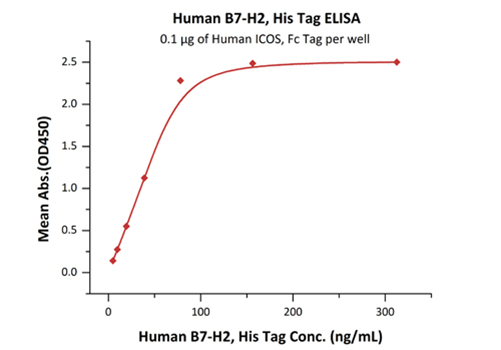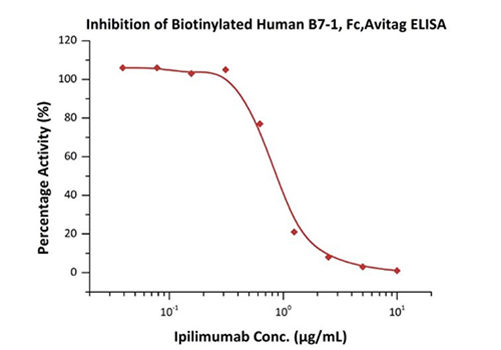 Stimulatory signal
Stimulatory signal  Inhibitory signal
Inhibitory signal
Arrows indicate interaction between receptor and ligand of B7 family members
Click the molecule name to view product details

Leave message
Can’t find what you’re looking for?
Fill out this form to inquire about our custom protein services!
Inquire about our Custom Services >>


































 Limited Edition Golden Llama is here! Check out how you can get one.
Limited Edition Golden Llama is here! Check out how you can get one.  Limited Edition Golden Llama is here! Check out how you can get one.
Limited Edition Golden Llama is here! Check out how you can get one.
 Offering SPR-BLI Services - Proteins provided for free!
Offering SPR-BLI Services - Proteins provided for free!  Get your ComboX free sample to test now!
Get your ComboX free sample to test now!
 Time Limited Offer: Welcome Gift for New Customers !
Time Limited Offer: Welcome Gift for New Customers !  Shipping Price Reduction for EU Regions
Shipping Price Reduction for EU Regions
> Famille B7-CD28: voie de co-stimulation importante dans la régulation immunitaire
Sur la base de la reconnaissance des antigènes dans la réponse immunitaire adaptative, l'activité des cellules T est largement réalisée lors de l'activation, où deux signaux sont nécessaires. Premièrement, les récepteurs des cellules T doivent engager spécifiquement les peptides présentés par les complexes majeurs d'histocompatibilité (CHM) sur les cellules présentatrices d'antigène (APC) ; deuxièmement, les récepteurs co-stimulateurs / co-inhibiteurs sur les cellules T doivent se lier à la famille des ligands B7 exprimée sur les APC pour réguler la situation des cellules T.
Cela fournit un point de contrôle clé dans la régulation de l'immunité par les cellules T. L'activation des cellules T est régulée par le système immunitaire inné par l'intermédiaire de molécules co-stimulatrices positives et négatives. Les recherches ont montré l'importance des membres de la famille B7 dans la régulation des réponses des cellules T. La famille des ligands B7 joue donc un rôle important dans les cancers humains et les maladies auto-immunes. La famille des ligands B7 comprend 11 membres, qui sont B7-1, B7-2, B7-H1, B7-DC, B7-H2, B7-H3, B7-H4, B7-H5, BTNL2, B7-H6 et B7- H7.
ACROBiosystems a développé des protéines exclusives de la famille B7 de haute pureté et à haute bioactivité, qui conviennent aux expériences sur l'immunité, le criblage d'anticorps, la SPR, la détection de l'activité cellulaire et à d'autres expériences, et peuvent accélérer le développement de médicaments à base d'anticorps.
 Stimulatory signal
Stimulatory signal  Inhibitory signal
Inhibitory signal
Arrows indicate interaction between receptor and ligand of B7 family members
Click the molecule name to view product details
| B7 family ligand | Ligand alias | Expression | Putative receptors | Role in T/NK cell responses | |
|---|---|---|---|---|---|
| Immune cells | Tumor | ||||
B7-H1 | PD-L1,CD274,PDCD1LG1 | + | + | PD-1 ,CD80 ,CD80 | Inhibition |
| B7-DC | PD-L2,CD273,PDCD1LG2 | + | + | PD-1,RGMB | Inhibition |
B7-1  | CD80,BB1,LAB-7,CD28LG1 | + | CD28,CTLA-4, PD-L1 | Activation/Inhibition | |
B7-2  | CD86,B70,LAB72,CD28LG2 | + | CD28 ,CTLA-4 ,CTLA-4 | Activation/Inhibition | |
B7-H3  | CD276,B7RP-2 | + | + | Unidentified | Activation/Inhibition |
| B7-H5 | VISTA,GI24,VSIR,SISP1,PD1H,DD1α | + | - | VSIG3 | Inhibition |
| B7-H2 | ICOS-L,ICOSLG,GL50,B7RP1,LICOS | + | ICOS,CD28 ,CTLA-4 ,CTLA-4 | Activation | |
| B7-H4 | B7x,B7S1,B7h.5,VTCN1 | + | + | Unidentified | Inhibition |
| B7-H6 | NCR3LG1,NR3L1 | - | + | NKp30 | Activation |
| B7-H7 | HHLA2,B7y | + | + | CD28H | Activation/Inhibition |
Inhibition
Activation
Activation/Inhibition
| Molecule | Cat. No. | Host | Product Description | Structure |
|---|
| Molecule | Cat. No. | Host | Product Description | Structure |
|---|
| Molecule | Cat. No. | Host | Product Description | Structure |
|---|

The purity of Human B7-H3, His Tag (Cat. No. B73-H52E2) is more than 90% and the molecular weight of this protein is around 30-40 kDa verified by SEC-MALS.
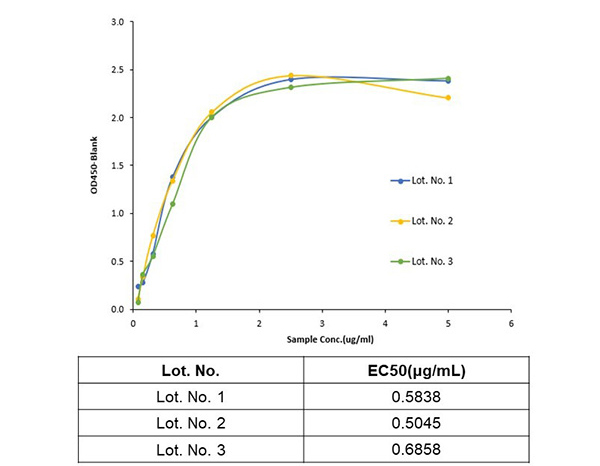
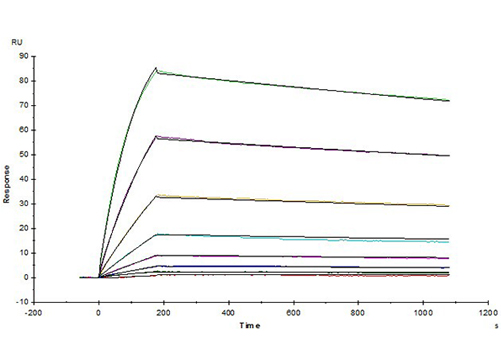
Anti-Human PD-L1 Mab (Human IgG1) captured on CM5 chip via anti-human IgG Fc antibodies surface, can bind Human PD-L1, His Tag (Cat. No. PD1-H5229) with an affinity constant of 0.286 nM as determined in a SPR assay (Biacore T200)(Routinely tested).
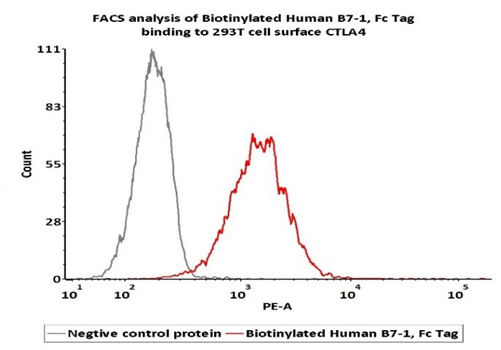
Flow Cytometry assay shows that Biotinylated Human B7-1, Fc,Avitag (Cat. No. B71-H82F2) can bind to 293 cell overexpressing human CTLA-4. The concentration of Human B7-1 is 0.3 μg/mL (Routinely tested).
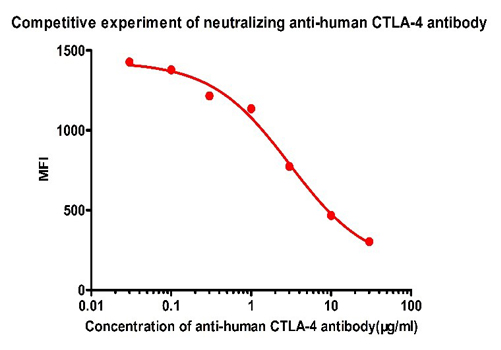
FACS analysis shows that the binding of Biotinylated Human B7-1, Fc,Avitag (Cat. No. B71-H82F2) to 293 overexpressing CTLA-4 was inhibited by increasing concentration of neutralizing Anti-Human CTLA-4 antibody. The concentration of B7-1 used is 0.3 μg/mL. The IC50 is 3.025 μg/mL (Routinely tested).
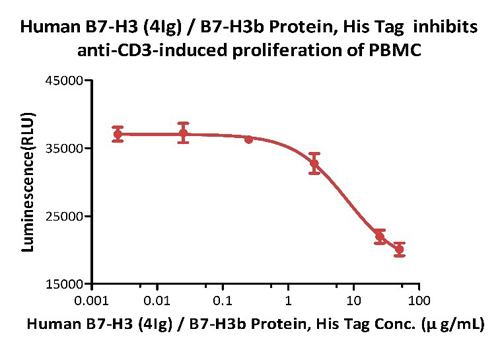
Human B7-H3 (4Ig), His Tag (Cat. No. B7B-H52E7) inhibits Anti-CD3-induced proliferation of PBMC. The EC50 for this effect is 7.95 μg/mL (Routinely tested).
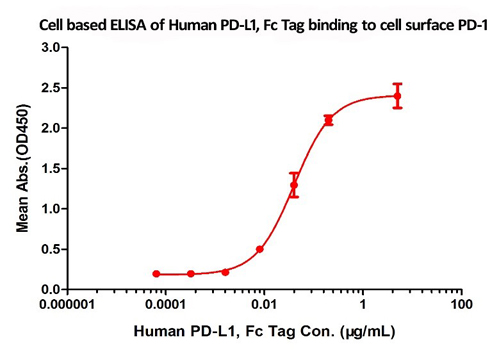
Immobilized cell surface PD-1 (5x104 of cells per well) can bind Human PD-L1, Fc Tag (Cat. No. PD1-H5258) with an EC50 of 0.029 μg/mL (Routinely tested).
This web search service is supported by Google Inc.









